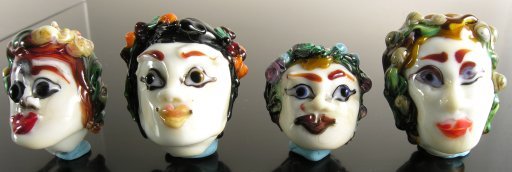After the difficulties with the brown, it was suggested to me that perhaps I might want to get good using glass a little easier to distinguish in the flame. Ivory is quite traditionally popular for faces, despite the fact that the people typically represented with it are not ivory, but, pale orange. Unfortunately, mixing ivory with orange doesn't yield nice flesh tones. Neither does mixing white, really, though I suppose I ought to try it. At any rate, ivory does have one quality that makes it ideal for practicing this stuff: its low viscosity. It melts easily and stays soft a long time, which is to say, it's nice and resistant to cracking.

sculptural heads, 2007. Effetre soda lime. tallest, 34mm high, 28mm wide, 32 mm deep. All hollow, built on 3/32” mandrels, using flame-dri release. Since only good beads deserve good photography, the handitac shows, as does the mirrow I use to bounce light on the left side. Ah well.
As with any sculptural technique, the trick is to work hot when moving large, gross shapes (in this case, forming the hollow bead on which the head is built) and going to a very cold working technique once one starts building individual features. Round beads, by contrast, don't demand nearly this range. I've believe I've stated before that GTT torches such as my lynx were designed in mind for the sculptural beadmaker, and I certainly appreciated being able to turn the flame way, way down when making noses. Even so, you can see, looking at these heads, which represent efforts 2–5 (#1 being the brown one I still need to locate and photograph) how I tended to work too hot.
The dark nose and spot between the brows on the bead all the way to the left comes from the fact that I was using what I thought was ivory but in fact was tongue pink. Tongue pink is sort of an off white when heated hot, and turns to sort of a liverwurst brown when struck...but reacts with the sulphur in ivory to make that dark reaction. So, I'd make the nose and it'd be black; I'd pluck it out, replace it, and it'd be black...eventually I figured it out.
The black dots at the corners of the lips of the black haired head was the tipoff: I'd plucked away the casing glass, allowing the interior lip color (opal yellow or silver pink) to just touch the ivory—and viola, sulphur reaction. The lips on the bead 2nd from the right was made with red cased with gold ruby, and they turned that icky color for similar reasons. The bead all the way to the right cracked, but I was able to detect (and so fix, or at least heal) the crack before it went into the kiln.
I particularly like the brown line on the upper left lid of the rightmost figure, but so far have been unable to duplicate it. I also really like the way the opaque brown shifts in intensity in her eyebrows, another feature that doesn't really show on the green glass. This head also shows what I consider to be a decent approach to irises: I take a navy floral stringer (leftover from this?), then dot with a lighter, periwinkle blue based floral stringer, (sorry no recipe, but basically periwinkle cased with clear and perhaps a white stripe or something—I promise to document this when it gets worthwhile) and then a hair-thin dot of standard black for the pupil. And yes, I still need to talk about plucking, but feel I ought to be able to make symmetrical faces (especially noses) first. That is my current goal with these things.
file created 15mar07.
Unless otherwise noted, text, image and objects depicted therein copyright 1996--present sylvus tarn.
Sylvus Tarn